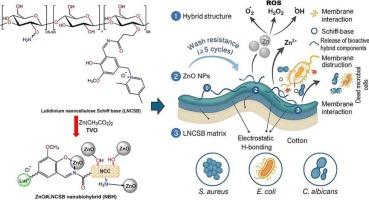Green engineering of lutidinium Schiff base nanocellulose–ZnO biohybrid as a durable antibacterial and UV-protective sustainable textile nanocoating
IF 7.3
2区 材料科学
Q1 CHEMISTRY, APPLIED
引用次数: 0
Abstract
This study details a green pathway for preparing a nanobiohybrid (NBH) from biogenic ZnO NPs and a synthesized nanocrystalline cellulose (NCC) matrix modified with a lutidinium Schiff base (LNCSB). Thymus vulgaris oil (TVO) acted as both bioreducing agent and stabilizer for the process yielding ZnO NPs. After validating the structures of LNCSB and NBH, the pad-dry-cure technique was applied to coat the cotton fabric, forming durable and multifunctional NBH-treated fabric. Spectroscopic (1H NMR, FTIR, XRD, EDX), microscopic (SEM, TEM), thermal, and mechanical measurements confirmed the successful formation of the LNCSB, NBH, and treated fabric. The NBH-coated cotton exhibited the following enhancements over the untreated cotton fabric: improved tensile strength, elongation, thermal stability, water repellency (WCA = 149.5°), and uniformity as well as mechanical integrity. In the meantime, the treated form demonstrated improved anti-UV activity with a UV protection factor (UPF) of 31.9 in contrast to the untreated fabric's UPF of 4.5. Additionally, even after fifteen demanding washing cycles, the NBH-coated textiles showed strong and long-lasting antimicrobial activity against S. aureus, E. coli, and C. albicans.

希夫碱纳米纤维素-氧化锌生物杂化织物纳米涂层的绿色工程研究
本研究详细介绍了由生物氧化锌NPs和合成的纳米晶纤维素(NCC)基质制备纳米生物杂化(NBH)的绿色途径,该纳米晶纤维素(NCC)基质经席夫碱(LNCSB)修饰。麝香油(TVO)作为氧化锌纳米粒子的生物还原剂和稳定剂。在验证了LNCSB和NBH的结构后,采用垫-干固化技术对棉织物进行涂覆,形成了耐用、多功能的NBH处理织物。光谱(1H NMR, FTIR, XRD, EDX),微观(SEM, TEM),热和机械测量证实了LNCSB, NBH和处理过的织物的成功形成。与未经处理的棉织物相比,涂覆nbh的棉织物表现出以下增强:抗拉强度、伸长率、热稳定性、拒水性(WCA = 149.5°)、均匀性和机械完整性。与此同时,经过处理的织物的抗紫外线活性有所提高,其紫外线防护系数(UPF)为31.9,而未经处理的织物的UPF为4.5。此外,即使经过15次苛刻的洗涤循环,nbh涂层纺织品对金黄色葡萄球菌,大肠杆菌和白色念珠菌表现出强大而持久的抗菌活性。
本文章由计算机程序翻译,如有差异,请以英文原文为准。
求助全文
约1分钟内获得全文
求助全文
来源期刊

Progress in Organic Coatings
工程技术-材料科学:膜
CiteScore
11.40
自引率
15.20%
发文量
577
审稿时长
48 days
期刊介绍:
The aim of this international journal is to analyse and publicise the progress and current state of knowledge in the field of organic coatings and related materials. The Editors and the Editorial Board members will solicit both review and research papers from academic and industrial scientists who are actively engaged in research and development or, in the case of review papers, have extensive experience in the subject to be reviewed. Unsolicited manuscripts will be accepted if they meet the journal''s requirements. The journal publishes papers dealing with such subjects as:
• Chemical, physical and technological properties of organic coatings and related materials
• Problems and methods of preparation, manufacture and application of these materials
• Performance, testing and analysis.
 求助内容:
求助内容: 应助结果提醒方式:
应助结果提醒方式:


